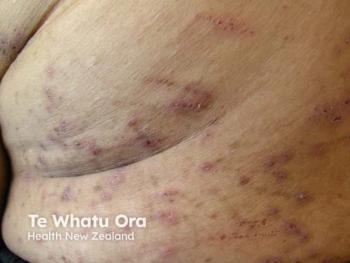
Closely monitoring xeroderma pigmentosum key to disease management
The early diagnosis of xeroderma pigmentosum (XP) is not only crucial for the timely implementation of therapeutic regimens in patients suffering from this disease; it's also key to keeping the development of cutaneous cancers to a minimum.
Key Points
Bethesda, Md. - The early diagnosis of xeroderma pigmentosum (XP) is not only crucial for the timely implementation of therapeutic regimens in patients suffering from this disease; it's also key to keeping the development of cutaneous cancers to a minimum.
XP is a rare, autosomal-recessive genetic disorder of DNA repair in which the ability to repair the damage caused by ultraviolet radiation is deficient. All patients with XP are photosensitive (in varying degrees), and some may burn even after minimal amounts of sun exposure.
Diagnosis and therapies
According to Dr. Kraemer, the National Institutes of Health has a specially designated protocol in place for XP patients, during which individuals are intensely examined with a palette of diagnostic studies over a three- to five-day period. Patients and their parents or guardians are educated about the disease, as well as their specific involvement in therapy, measures for protection against further damage and monitoring for disease progression. After the visit, an extensive report is sent to the patient's dermatologist, who will continue to follow the patient in the future.
Several therapeutic approaches have been tried in patients with XP, but most of them prove inadequate or are associated with significant adverse events. Patients can be treated with oral isotretinoin, which has shown to cause a dramatic reduction in the frequency of new skin cancers, but the side effects of the medication can be severe.
Education counts
Educating patients, physicians and the general public about the signs and symptoms of XP is critical, as this could lead to earlier recognition of the disease and subsequent earlier diagnosis. According to Dr. DiGiovanna, an early diagnosis can have an enormous impact on the morbidity - and sometimes mortality - of the patient.
"One of the main hallmarks of the disease in XP patients is an extreme hypersensitivity to ultraviolet (UV) radiation. Eliminating the ultraviolet radiation essentially eliminates all of the damage that it can cause the patient," Dr. DiGiovanna says. "In those patients in whom an early diagnosis of XP could be made, there are virtually no signs of visible sun damage and extremely low levels and sometimes no skin cancers seen," Dr. DiGiovanna says.
This underscores the extreme importance of appropriately educating patients as well as actively protecting the skin from ultraviolet radiation. According to Dr. Kraemer, XP patients must practice sun avoidance and whenever necessary use good sunscreen protection.
XP patients should limit their activities to the indoors or at night. If they are done outside, the patient must use appropriate sunblocks and cover with a broad-brimmed hat and long-sleeved clothing. Patients can also don NASA-like suits when participating in outdoor activities. These suits serve as a head-to-toe physical skin barrier, fully protecting patients from UV radiation.
"Using these methods of protection, XP patients now can have a better life expectancy and have a significantly decreased frequency of skin cancers as compared to years before, where they would typically show signs of premature skin aging and develop numerous skin cancers at a very young age," Dr. Kraemer says.
Newsletter
Like what you’re reading? Subscribe to Dermatology Times for weekly updates on therapies, innovations, and real-world practice tips.


















